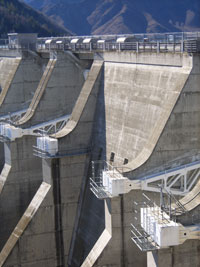Hydro Power as a Socially Responsible Way to Generate Electricity
Download Audio VersionHydro power is used to generate electricity and is derived from different sources such as running and falling water. There are power stations with a large production capacity, and the biggest ones are located in Paraguay and China.
Types of Plants and Designs
There are three types of facilities – small, medium, and large. Small plants have a capacity of up to 10 MW while medium ones produce between 10 and 50 MW. Large plants have a capacity of over 50 MW. Different technologies are used to produce electricity. Examples are pumped storage, diversion, and impoundment technologies. Impoundment facilities incorporate turbines, damns, and generators to store water and produce electricity. Pumped storage facilities are suitable for areas in which the demand for electric power is relatively low during some periods. Diversion technologies are also used to direct water through canals.
Benefits for Households and the Environment
Hydroelectricity is clean and affordable which makes it an eco-friendly alternative to power produced from fossil fuels. It supplements other sources such as geothermal and solar energy. Moreover, river water is a domestic resource unlike gas, coal, and other materials that are imported. Price and market fluctuations occur less often. Other advantages are reliability, flexibility, and better cost efficiency.

Electricity systems depend on different factors such as constant voltage levels and a mix of energy sources. Hydro power is used to maintain a good balance between demand and supply. Moreover, the reservoirs offer plenty of opportunities for recreation – boating, swimming, fishing, and others. Flood and water control are added advantages.
A Clean and Natural Source
Energy production does not generate greenhouse gases, acid rain, and other pollutants that contribute to poor air quality. The need for non-renewable fuels and fossils such as coal, gas, and oil is also reduced. This is an infinite source that is secure and natural. Water is not depleted, wasted, or consumed during the production process. Turbines and production facilities convert over 90 percent of energy into electric power which makes them very efficient. This is a reliable technology that generates energy for commercial enterprises and households. The industry also promotes efforts toward efficiency and conservation because the demand for electricity is on the rise in the developed world. The main reasons are economic and population growth that are expected to continue. Hydro power is the major source of electricity is some countries. In Canada, for example, hydroelectricity accounts for about 60 percent of the total energy produced. The construction of new plants and facilities will create hundreds of thousands of jobs during the next two decades. The country is also a major exporter to large markets such as the U.S.
Construction, Assessment, and New Developments
In the developed countries, each stage is carefully assessed, from planning and design to construction, installation, and operation. The goal is to assess and minimize pollution and impact on the environment.
New technologies and developments feature tidal, ocean wave, and kinetic designs. Companies work to improve the performance, flexibility, and design of power plants. Intake gates and fish-friendly technologies are some of the innovative solutions.
Benefits for Local Communities
As an added benefit, production facilities create employment opportunities and contribute to the welfare of local communities. The operation and construction phases create jobs for thousands of workers. Local and regional district tax revenues also contribute to the wellbeing of local communities. The fact that water is a local source makes it secure and reliable. It is not subject to transportation and extended periods of supply disruptions.
Hydro power plants are usually built close to transmission lines, roads, and other infrastructure. This helps reduce air pollution and environmental impact. Land is cleared for industrial use, and the switchyard and powerhouse and installed there. The production facilities bring commerce, industry, roads, highways, and energy to local communities. This helps expand access to quality education and healthcare.
Another benefit is the fact that the installations are long-term investments. They have a lifespan of up to 100 years and can be upgraded to reduce the repair and maintenance costs. In this way, hydro power plants contribute to sustainable development and are an economically viable alternative to other sources of electricity.
Downsides and Costs
The major downside is the initial upfront cost for building production facilities. Another problem is stream regiment fluctuation that has an impact on plants and fish species. Temperature and flow patterns are also factors that affect production.
Related Articles
Sustainable Energy Sources as a Safe Alternative and the Source of Clean Electricity
There are different sources of sustainable energy, including thermal, solar, wind, and ocean power. In general, alternative energy is produced by exploiting sources that are different than fossil fuels such as petroleum and coal. Ecologically friendly sources help reduce carbon dioxide emissions...
Wave Power as a Way to Meet Global Energy Hunger
Wave power is used for pumping, water desalination, generation of electricity, and more. Due to its high power density, researchers view it as one of the least expensive sources of renewable energy to be used in the foreseeable future. According to the World Energy Council, wave power could account...
Geothermal Energy as a Clean Source That Reduces Dependence
Geothermal energy is in the form of heat that is found and used in different locations, from Iceland and Italy to Japan and Kenya. It is used to heat office buildings and residential units. Geothermal energy is produced by pumping systems, large power stations, and other types of technologies. This...
Wind Power as a Reliable Source of Clean Energy
Wind power is transformed into energy through different technologies, including wind farms, turbines, generators, and others. The goal is to meet the increasing energy demand on a global level by using clean and renewable sources. Turbines Generate PowerWind turbines transform kinetic into...


